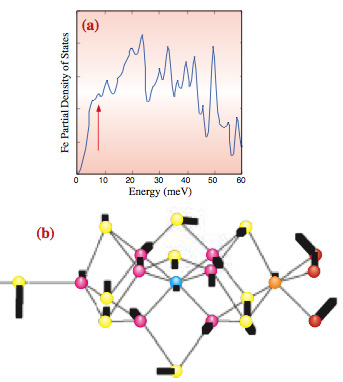核共鳴非弾性散乱による酵素ニトロゲナーゼの振動状態の測定
Inquiry number
SOL-0000001309
Beamline
BL09XU (HAXPES I)
Scientific keywords
| A. Sample category | organic material |
|---|---|
| B. Sample category (detail) | protein, environmental material |
| C. Technique | inelastic scattering, nuclear excitation, Mössbauer effect |
| D. Technique (detail) | nuclear excitation, nuclear resonance |
| E. Particular condition | low-T (~ liquid N2), time-resolved (ns) |
| F. Photon energy | X-ray (4-40 keV) |
| G. Target information | local structure, phonon |
Industrial keywords
| level 1---Application area | environment, Pharmaceuticals |
|---|---|
| level 2---Target | catalysis, drug design |
| level 3---Target (detail) | protein |
| level 4---Obtainable information | local structure |
| level 5---Technique | scattering |
Classification
A80.34 catalysis, A80.40 environmental materials
Body text
核共鳴非弾性散乱はある特定の元素のフォノン状態密度を調べることのできるユニークな手法です。この手法を用いることで、メスバウアー元素を含む固体、液体、非晶質等の局所振動状態を測定することができます。核共鳴散乱がメスバウアー元素だけにより生じることから、タンパク質などの高分子試料中でも、特定の元素の振動状態だけをとりだして解析することが可能です。
図に示すのは、ニトロゲナーゼ酵素について測定したフォノン状態密度です。この結果から、それぞれの振動モードがどのように寄与しているかがわかりました。
図 ニトロゲナーゼ酵素のフォノン状態密度(a)。
(b)に示すねじれのモードが10 meV付近のピークとして現れています。
Source of the figure
Bulletin from SPring-8
Bulletin title
Research Frontiers 2003
Page
69
Technique
Source of the figure
Required time for experimental setup
Instruments
References
Related experimental techniques
Questionnaire
The measurement was possible only in SPring-8. Impossible or very difficult in other facilities.
This solution is an application of a main instrument of the beamline.
Similar experiments account for more than 30% of the beamline's subject.
Ease of measurement
Middle
Ease of analysis
Middle
How many shifts were needed for taking whole data in the figure?
Two-three shifts

